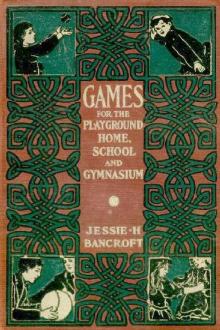Games for the Playground, Home, School and Gymnasium by Jessie Hubbell Bancroft (top novels of all time .txt) 📕

- Author: Jessie Hubbell Bancroft
- Performer: -
Book online «Games for the Playground, Home, School and Gymnasium by Jessie Hubbell Bancroft (top novels of all time .txt) 📕». Author Jessie Hubbell Bancroft
A very interesting form of this game for the gymnasium allows no two players to hang from the same piece of apparatus; the last one taking possession has the right to remain hanging on the apparatus, the one before him being obliged to run at once for another place. This keeps the players moving and makes the game very lively.
TREE TOAD.—This is a form of Hang Tag played by the modern Greeks. It is played where there are trees, the players jumping to clasp the trunk of the tree as a means of lifting their feet from the ground when the branches are too high to reach. This makes a very funny, vigorous, and interesting form of the game, to be played in a grove or shaded lawn.
HAVE YOU SEEN MY SHEEP?10 to 30 or more players.
Playground; parlor; gymnasium; schoolroom.
The players stand in a circle. One walks around on the outside, and touching one of the circle players on the back, asks, "Have you seen my sheep?" The one questioned answers, "How was he dressed?" The outside player then describes the dress of some one in the circle, saying, for instance, "He wears a red necktie; he is dressed in gray and has low shoes." The one questioned then names the player whom he thinks this describes, and if right, at once begins to chase him around the outside of the circle. Each of the circle players must be very alert to recognize himself in the description given by the outside player, for immediately that he is named he must run around the outside of the circle, chased by the player who guessed, and try to reach his own place before being tagged. The one who gives the description does not take part in the chase. Should the runner be tagged before returning to his place, he must take the place of the questioner, running in his turn around the outside of the circle and asking of some player. "Have you seen my sheep?"
IN THE SCHOOLROOM.—The players remain seated, with the exception of the one who asks the first question of any player he chooses. This player at once stands, guesses the player described, and chases him around the room, the one chased trying to gain his seat before being caught. If caught, he becomes questioner; if not caught, the same questioner and guesser play as before.
HIDE AND SEEKThe following games of hiding and seeking will be found in alphabetical order:—
2 to 20 or more players.
Indoors; out of doors.
This is a simple form of "I spy," played by very little children. One covers his eyes or blinds and the others hide. When securely hidden, they call "Coop!" and the one who is It goes in search of them. The call of "Coop!" may be repeated at the discretion of the hider. In this game the object is won when the searcher discovers the hidden players. There is no race for a goal as in "I spy."
HIDE THE THIMBLE5 to 60 players.
Schoolroom; parlor.
One player is sent from the room; while absent, one of those remaining hides a thimble, a cork, or some small object which has been previously shown to the absent one. When the object is hidden, the absent player is recalled, and proceeds to hunt for the hidden object. While he is doing this, the others sing or clap their hands, the sound being very soft and low when the hunter is far away from the object, and growing louder as he approaches it. The piano music is desirable, but for schoolroom use singing is found to be more interesting for all, as well as often more practicable. For very little children hand clapping is pleasing and sometimes more easily used than singing.
HIGH WINDOWS10 to 30 or more players.
Playground; gymnasium.
All of the players but one join hands in a circle. The odd player in the center runs around on the inside of the circle and hits one of the players with a wisp of grass, if the game be played out of doors, or tags him if played indoors. Both players then run out of the circle, it being the object of the player who was tagged to catch the odd player before he can run three times around the outside of the ring. As the runner completes his third time around, the players in the circle cry "High Windows!" and raise their clasped hands to let both of the players inside. Should the one who is being chased succeed in entering the circle without being tagged, he joins the circle and the chaser takes his place in the center. Should the chaser tag the pursued before he can circle the ring three times and dodge inside at the close, the chaser returns to the circle and the one caught goes again into the center.
It is permissible to vary the chase by running away from the immediate vicinity of the circle. Should the chase then become too long, the circle players may call "High Windows!" as a signal for the runners to come in. This call is made at the discretion of a leader, whether he be one of the circle players appointed for that purpose, or a teacher.
HILL DILL10 to 30 or more players.
Playground; gymnasium.
Two parallel boundary lines are drawn from thirty to fifty feet apart; or the game is often played between the curbings of a street, which serve as boundaries. One player is chosen to be It, and stands in the center. The other players stand in two equal parties beyond the boundary lines, one party on each side. The center player calls out, "Hill, dill! come over the hill!" The other players then exchange goals, and as they run across the open space the one in the center tries to tag them. Any who are tagged assist him thereafter in tagging the others.
This game is not well adapted to very large numbers of players, as it brings two opposing parties running toward each other in the exchange of goals. It is especially suited to conditions where a very wide central field lies between the goals, thus giving opportunity for the players to scatter.
HIP5 to 30 or more players.
Playground.
All of the players stand in an informal group. One of them is provided with a stick about the size of a broomstick and about two feet long. He throws this as far as he can, at the same time calling the name of one of the other players. The one who threw the stick, and all the others except the one whose name is called, then scatter in a run. The one who is called must pick up the stick, whereupon he becomes "Hip" and must chase the other players. Any player whom he catches he touches with the stick (pounding not allowed), and that player at once joins him in trying to catch the others. Any one caught by the second player, however, must be held by him until Hip can come and touch the prisoner with the stick, whereupon he also joins Hip's party. As the number of players with Hip increases, there may be some pretty lively "tussling" on the part of players who are caught, pending the arrival of Hip to touch them with the stick, as he may have several to reach in this way, and the interval may be considerable in which the captor must hold his victim. The game ends when all of the players have been touched by Hip.
HOME TAG4 to 60 or more players.
Indoors; out of doors.
One player is It, or chaser, and changes places with any one whom he can touch (tag) outside of the safety places called homes. One or more such places are chosen to which the players may run at any time for safety. It is advisable to have these homes widely separated, as at opposite ends of the playground. If the players resort to these homes too frequently to make a good game, the chaser may call
Who does not run is mine."
Whereupon every player must run out from his home or goal, or change places with the tagger.
HOPPING RELAY RACE10 to 100 players.
Playground; gymnasium; schoolroom.
A starting line is drawn on the ground, behind which the players stand in two or more single files, facing a goal. The goal should be ten or more feet from the starting line, and may consist of a wall, or a line drawn on the ground. At a signal the first player in each line hops on one foot to the goal, touches it with his hands (stooping for this if it be a line on the ground), and hops back to the end of his line, which should have moved forward to fill his place as he started. He takes his place at the rear end of the line. He tags the first player in the line as he passes him, and this player at once hops forward to the goal. Each player thus takes his turn, the line winning whose last player first reaches the rear of his line, and there raises his hand as a signal.
If the game be repeated, the hopping in the second round should be on the opposite foot.
FOR THE SCHOOLROOM.—This may be played in the class room by having an equal number of pupils in each row of seats. The players remain seated until it is their turn to hop, each hopping from his own seat to the forward blackboard and back to his seat again; or the distance may be made greater by continuing past his seat to the rear wall and then back to his seat again. The game starts with those in the rear seats. Each pupil as he takes his seat tags the pupil seated next in front of him, who takes this as a signal to start. The line wins whose player in the front seat first returns and raises a hand to show he is seated.
HOUND AND RABBIT10 to 60 or more players.
Playground; gymnasium; schoolroom.
A considerable number of the players stand in groups of three, with their hands on each other's shoulders, each group making a small circle which represents a hollow tree. In each tree is stationed a player who takes the part of rabbit. There should be one more rabbit than the number of trees. One player is also chosen for hound.
The hound chases the odd rabbit, who may take refuge in any tree, always running in and out under the arms of the players forming the tree. But no two rabbits may lodge in the same tree; so as soon as a hunted rabbit enters a tree, the rabbit already there must run for another shelter. Whenever the hound catches a rabbit, they change places, the hound becoming rabbit and the rabbit hound. Or the hound may at any time become a rabbit by finding shelter in an empty tree, whereupon the odd rabbit who is left without shelter must take the part of the hound.
This game may be made very lively, and has much sport in it even for adults. The trees should be scattered promiscuously so that both rabbits and hound may have many opportunities to dodge and run in various directions, with false starts and feints that add zest and interest to such a game.
For large numbers of players it is advisable to give each a better





Comments (0)